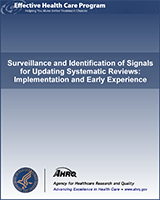NCBI Bookshelf. A service of the National Library of Medicine, National Institutes of Health.
Newberry SJ, Ahmadzai N, Motala A, et al. Surveillance and Identification of Signals for Updating Systematic Reviews: Implementation and Early Experience [Internet]. Rockville (MD): Agency for Healthcare Research and Quality (US); 2013 Jun.

Surveillance and Identification of Signals for Updating Systematic Reviews: Implementation and Early Experience [Internet].
Show detailsObjectives
Between May 2011 and August 2012, under contract with the U.S. Agency for Healthcare Research and Quality (AHRQ), the ECRI Institute Evidence-based Practice Center (EPC) assisted the Southern California EPC—RAND Corporation and the Ottawa EPC in updating reports for the Effective Health Care (EHC) Program. ECRI's role in this project was to provide information about alerts and updates on specific drugs, products, and medical devices that might warrant an update for major sections—such as key questions, discussions, and conclusions—of comparative effectiveness reports (CERs) published under the EHC Program since 2008.
Methods
The RAND EPC provided ECRI Institute with a list of targeted CERs published and posted on the EHC Web site since 2008.
ECRI Institute conducted daily Web site surveillance for advisory information from the U.S. Food and Drug Administration (FDA), Health Canada, and the United Kingdom's Medicines and Healthcare products Regulatory Agency (MHRA). We monitored these Web sites for their content on drug- and device-related activity, specifically, drug approvals and alerts and device approvals/clearances, safety alerts, and recalls. The drug products and medical devices associated with an alert were cross-checked against the final CERs posted on the EHC Program Web site.
Besides ensuring daily surveillance for identified topics, we performed comprehensive searches for selected reports using ECRI Institute's Health Devices Alerts database. Examples of such reports include: Radiofrequency Catheter Ablation for Atrial Fibrillation, Diagnosis and Treatment of Obstructive Sleep Apnea, and Devices to Remove Thrombus and/or Protect from Distal Embolization in Acute Coronary Syndrome Patients Undergoing Percutaneous Coronary Intervention of Native Vessels.
Final EHC reports that were not included in the initial list were outside the scope of our surveillance activity. However, we did review some excluded CERs for related alerts when specific requests were made by either the RAND or Ottawa EPCs.
Literature Scope
ECRI Institute medical librarians directed the ECRI Institute principal investigator on indexing the conditions and interventions addressed in AHRQ CERs to map to the final EHC reports the drug products and medical devices flagged during surveillance. ECRI Institute research analysts routinely monitored the following resources for drug- and device-related notifications:
- ECRI Institute Health Devices Alerts Database (subscription required)
- Health Canada—Advisories, Warnings and Recalls
- Medicines and Healthcare products Regulatory Agency (United Kingdom)
- Medicines and Healthcare products Regulatory Agency—Drug Alerts
- Medicines and Healthcare products Regulatory Agency—Drug Safety Update
- Medicines and Healthcare products Regulatory Agency—Medical Device Alerts
- U.S. Food and Drug Administration—CDRH Consumer News
- U.S. Food and Drug Administration—CDRH Medical Device Recalls since December 20, 2010
- U.S. Food and Drug Administration—CDRHNew
- U.S. Food and Drug Administration—Drug Shortages
- U.S. Food and Drug Administration—Enforcement Report
- U.S. Food and Drug Administration—MedWatchSafety Alert RSS Feed
- U.S. Food and Drug Administration—Patient Safety News
- U.S. Food and Drug Administration—Press Releases
- U.S. Food and Drug Administration—Recalls/Safety Alerts
Data Abstraction and Synthesis
The data abstracted from the regulatory agencies' Web sites were organized in summary tables. ECRI Institute then generated and submitted monthly alert summary reports to the RAND and Ottawa EPCs. Our monthly reports captured drug- and device-related activity reported on the FDA, Health Canada, and MHRA Web sites during the previous month. No newly-approved drug products or medical devices relevant to our list of targeted CERs were identified via our surveillance. The reports submitted to the two EPCs included the following information:
- Drug or device notification and surveillance activity date
- EHC report most likely to be affected by the notification
- Type of notification
- Content of notification as reported by the regulatory agency
- Link (Internet address) to notification
- Any ongoing safety reviews by other organizations
- Description of potential update needed, mapped to the corresponding section of the CER
Drug notifications were reported as:
- Drug Advisory
- Drug Safety Labeling Change
- Withdrawal
- Drug Safety Communication
Device notifications were reported as:
Manufacturer and User Facility Device Experience (MAUDE) Adverse Event Report
- Methods for Identifying Regulatory Information or Safety Alerts - Surveillance a...Methods for Identifying Regulatory Information or Safety Alerts - Surveillance and Identification of Signals for Updating Systematic Reviews: Implementation and Early Experience
Your browsing activity is empty.
Activity recording is turned off.
See more...